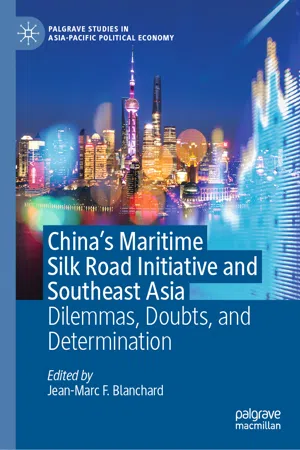The twenty-first-Century Maritime Silk Road Initiative (MSRI) is one of the two legs of the Belt and Road Initiative/BRI (previously known as One Belt, One Road or OBOR), China’s overarching development plan and foreign strategy . Aiming to revive the ancient Maritime Silk Road starting from China’s coastal regions , the MSRI traverses a vast expanse of oceans to countries in Southeast Asia (SEA), the Middle East, Africa, and Europe.1 Whether the MSRI can succeed, however, is contingent not only on China’s own capacity, but also on other countries’ responses. As Chinese President Xi Jinping underscores, “The programs of development (MSRI) will be open and inclusive, not exclusive. They will not be a solo for China, but a real chorus comprising all countries along the routes.”2
SEA countries are not only an important testing ground for the MSRI, but also act as a bridge and springboard to other regions and thus are crucial to the progress of China’s MSRI. Given this, understanding these countries’ response to China’s MSRI is an important endeavor.3 The task is interesting from an analytical standpoint because the members of the Association of Southeast Asian Nations (ASEAN) have quite diverse perceptions of China’s MSRI and reactions to it.4 In this chapter, we not only discuss the various ASEAN governments’ responses toward the MSRI since 2014, but also provide a framework to illuminate the variation.
We argue that their variance has largely been caused by their changing domestic politics , specifically, the policy priorities of ruling elites, degree of trust of China, leaders’ ideology and preference, and societal reactions. The MSRI promises greater regional connectivity through growing infrastructure networks as well as increased trade and investment, but in the process of implementing it, China needs to pay more attention to the risks and concerns of SEA countries.
The next section provides a picture and measurement of SEA countries’ responses to China’s MSRI, followed by an elaboration of the three classification categories (Tier 1, Tier 2, and Tier 3) that we use to label SEA countries with similar stances toward the MSRI. The last section explains why countries fall into the different categories.
Responses of SEA Countries to China’s MSRI: Overview and Measurement
SEA countries differ in extent to which they embrace or counter the MSRI because of various concerns they have about it and the likely consequences of joining it. Looking at their responses to China’s MSRI, ASEAN countries can be classified into three groups: those strongly supporting it (“Tier 1” states), those supporting it albeit with strong reservations (“Tier 2” states), and those that strongly oppose it (“Tier 3” states). Worth noting is that there are “swing states” or states that have fallen into different tiers at different points in time.5
Table
1 shows the distribution of states into these categories.
Table 1Stance of SEA countries towards MSRI
Degree of support | Countries |
|---|
Tier 1: Strongly supportive | Cambodia, Laos, Thailand |
Tier 2: Conditionally supportive | Indonesia, Singapore, Brunei, Myanmar |
Swing state | Tier 1: Strongly supportive | Malaysia under Najib |
Tier 2: Conditionally supportive | Malaysia under Mahathir; Vietnam after the 12th Party Congress; the Philippines under Duterte |
Tier 3: Least supportive | Vietnam before the 12th Party Congress; the Philippines under Aquino III |
Although they fully support the MSRI to gain economic benefits from it, countries in Tier I do have some concerns about issues such as project management and product quality. Countries in Tier 2 are more hesitant to join China’s MSRI and thus have been hedging against it even though they expect to benefit from it. Their hedging reflects a reluctance to take any risk that may be brought about by Chinese investment. The oscillating stance of swing states toward China’s MSRI has, at one extreme, entailed hard balancing where the relevant state resists the MSRI, even aligning with other powers to counterbalance China, and, at the other extreme, the relevant state acts like Tier 2 countries.
We used two types of indicators to gauge the degree of SEA countries’ support for the MSRI and assign different values to each SEA country using these indicators. One is “symbolic gestu...
